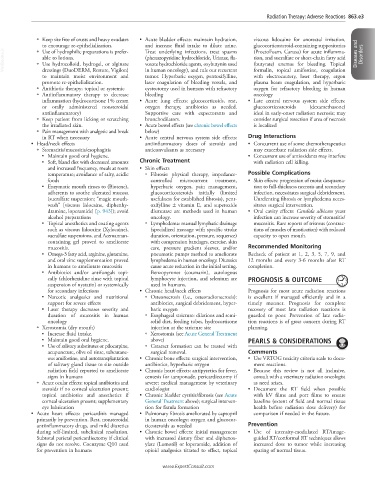Page 1716 - Cote clinical veterinary advisor dogs and cats 4th
P. 1716
Radiation Therapy: Adverse Reactions 863.e3
○ Keep site free of crusts and heavy exudates • Acute bladder effects: maintain hydration, viscous lidocaine for anorectal irritation,
to encourage re-epithelialization. and increase fluid intake to dilute urine. glucocorticosteroid-containing suppositories
VetBooks.ir ○ Use hydrocolloid, hydrogel, or alginate (phenazopyridine hydrochloride, Urimax, fla- tion, and sucralfate or short-chain fatty acid Diseases and Disorders
Treat underlying infections, treat spasms
(ProctoFoam, Canasa) for acute inflamma-
○ Use of hydrophilic preparations is prefer-
able to lotions.
(butyrate) enemas for bleeding. Topical
voxate hydrochloride agents, oxybutynin used
dressings (DuoDERM, Restore, Vigilon)
tumor. Hyperbaric oxygen, pentoxifylline,
with electrocautery, laser therapy, argon
to maintain moist environment and in human oncology), and rule out recurrent formalin, topical amifostine, coagulation
promote re-epithelialization. laser coagulation of bleeding vessels, and plasma beam coagulation, and hyperbaric
○ Antibiotic therapy: topical or systemic cystectomy used in humans with refractory oxygen for refractory bleeding in human
○ Antiinflammatory therapy to decrease bleeding oncology
inflammation (hydrocortisone 1% cream • Acute lung effects: glucocorticoids, rest, • Late central nervous system side effects:
or orally administered nonsteroidal oxygen therapy, antibiotics as needed. glucocorticosteroids (dexamethasone)
antiinflammatory) Supportive care with expectorants and ideal in early-onset radiation necrosis; may
○ Keep patient from licking or scratching bronchodilators. consider surgical resection if area of necrosis
the irradiated skin. • Acute bowel effects (see chronic bowel effects is localized
○ Pain management with analgesic and break below)
in RT when necessary • Acute central nervous system side effects: Drug Interactions
• Head/neck effects antiinflammatory doses of steroids and • Concurrent use of some chemotherapeutics
○ Stomatitis/mucositis/esophagitis anticonvulsants as necessary may exacerbate radiation side effects.
Maintain good oral hygiene. • Concurrent use of antioxidants may interfere
■
Soft, bland diet with decreased amounts Chronic Treatment with radiation cell killing.
■
and increased frequency, meals at room • Skin effects
temperature; avoidance of salty, acidic ○ Fibrosis: physical therapy, impedance- Possible Complications
foods controlled microcurrent treatment, • Skin effects: progression of moist desquama-
Enzymatic mouth rinses to (Biotene), hyperbaric oxygen, pain management, tion to full-thickness necrosis and secondary
■
adherents to soothe ulcerated mucosa glucocorticosteroids initially (limited infection, necessitates surgical debridement.
(sucralfate suspension; “magic mouth- usefulness for established fibrosis), pent- Unrelenting fibrosis or lymphedema neces-
wash” [viscous lidocaine, diphenhy- oxifylline ± vitamin E, and superoxide sitates surgical intervention.
dramine, loperamide] [p. 943]); avoid dismutase are methods used in human • Oral cavity effects: Candida albicans yeast
alcohol preparations oncology. infection can increase severity of stomatitis/
Topical anesthetics and coating agents ○ Lymphedema: manual lymphatic drainage mucositis. Rare reports of trismus (contrac-
■
such as viscous lidocaine (Xylocaine), (specialized massage with specific stroke tions of muscles of mastication) with reduced
sucralfate suspensions, and Acemannan- duration, orientation, pressure, sequence) capacity to open mouth.
containing gel proved to ameliorate with compression bandages, exercise, skin
mucositis. care, pressure gradient sleeves, and/or Recommended Monitoring
Omega-3 fatty acid, arginine, glutamine, pneumatic pumps method to ameliorate Recheck of patient at 1, 2, 3, 5, 7, 9, and
■
and oral zinc supplementation proved lymphedema in human oncology. Diuretics 12 months and every 3-6 months after RT
in humans to ameliorate mucositis cause acute reduction in the initial setting. completion.
Antibiotics and/or antifungals topi- Benzopyrones (coumarin), autologous
■
cally (chlorhexidine rinse with topical lymphocyte injection, and selenium are PROGNOSIS & OUTCOME
suspension of nystatin) or systemically used in humans.
for secondary infections • Chronic head/neck effects Prognosis for most acute radiation reactions
Narcotic analgesics and nutritional ○ Osteonecrosis (i.e., osteoradionecrosis): is excellent if managed efficiently and in a
■
support for severe effects antibiotics, surgical debridement, hyper- timely manner. Prognosis for complete
Laser therapy decreases severity and baric oxygen recovery of most late radiation reactions is
■
duration of mucositis in human ○ Esophageal stricture: dilations and semi- guarded to poor. Prevention of late radia-
oncology solid diet, feeding tubes, hydrocortisone tion reactions is of great concern during RT
○ Xerostomia (dry mouth) injection at the stricture site planning.
Increase fluid intake. ○ Xerostomia (see Acute General Treatment
■
Maintain good oral hygiene. above)
■ PEARLS & CONSIDERATIONS
Use of salivary substitutes or pilocarpine, ○ Cataract formation can be treated with
■
acupuncture, olive oil rinse, subcutane- surgical removal. Comments
ous amifostine, and autotransplantation • Chronic bone effects: surgical intervention, • Use VRTOG toxicity criteria scale to docu-
of salivary gland tissue to site outside antibiotics, hyperbaric oxygen ment reactions.
radiation field reported to ameliorate • Chronic heart effects: antipyretics for fever, • Because this review is not all inclusive,
signs in humans centesis for tamponade, pericardiectomy if consult with a veterinary radiation oncologist
○ Acute ocular effects: topical antibiotics and severe; medical management by veterinary as need arises.
steroids if no corneal ulceration present; cardiologist • Document the RT field when possible
topical antibiotics and anesthetics if • Chronic bladder cystitis/fibrosis (see Acute with kV films and port films to ensure
corneal ulceration present; supplementary General Treatment above); surgical interven- baseline (extent of field and normal tissue
eye lubrication tion for fistula formation health before radiation dose delivery) for
• Acute heart effects: pericarditis managed • Pulmonary fibrosis ameliorated by captopril comparison if needed in the future.
primarily by prevention. Rest, nonsteroidal in human oncology; oxygen and glucocor-
antiinflammatory drugs, and mild diuretics ticosteroids as needed Prevention
during self-limited, subclinical resolution. • Chronic bowel effects: initial management • Use of intensity-modulated RT/image-
Subtotal parietal pericardiectomy if clinical with increased dietary fiber and diphenox- guided RT/conformal RT techniques allows
signs do not resolve. Coenzyme Q10 used ylate (Lomotil) or loperamide, addition of increased dose to tumor while increasing
for prevention in humans opioid analgesics titrated to effect, topical sparing of normal tissue.
www.ExpertConsult.com

